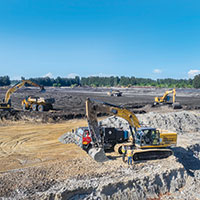 South County seeing 3,000-home building boom
South County seeing 3,000-home building boom
STORY BY STEVEN M. THOMAS (Week of August 28, 2025)
A sprawling masterplan for seven interconnected subdivisions – with a park and commercial area at their core – is finally roaring back to life in the southern part of Indian River County.
Just a 10-minute drive west of the barrier island, the throaty diesel growl of heavy construction equipment serves notice that site preparation is underway for residential development originally approved by county’s Planning and Zoning Commission 20 years ago.
At its widest, east to west, the South County Conceptual Master Plan Area extends from 20th Avenue to a quarter of a mile west of 43rd Avenue. North to south, it starts at 13th Street SW, several blocks below Oslo Road, and stretches down to the St. Lucie County line at 25th Street SW.
In total, the plan area and adjacent subdivisions will encompass nearly two square miles and include about 3,000 homes at buildout.
Some of the original components of the plan, including an elementary school and sections of multifamily housing, have been erased from the drawing board, but the scope and essential elements remain in place.
“The initiative is still alive and intact,” says Ryan Sweeney, assistant planning and development services director for Indian River County. “It is not a full-on New Urbanism kind of thing, but it has the elements of a nice, cohesive plan. I would call it a ‘lite’ version of master planning at this point.”
The subdivisions underway or close to commencement in and around the planning area will bring about 450 new homes to market over the next several years.
Other subdivisions shown on the plan but still dormant include another 1,000 to 1,200 new, single-family homes.
The houses already built in Falcon Trace and Millstone Landing also are part of the conceptual plan.
The history of the plan is tied to the two major real estate booms and one epic bust seen so far this century.
“When the boom ramped up [back in 2004], things were going crazy,” Sweeney said. “The P&Z board was being bombarded with requests for planned developments, and the conceptual master plan was a way of slowing things down and exerting more control over development.”
Planned developments, or PDs, sidestep some zoning regulations and give builders more flexibility in their developments, including the ability to increase density. In exchange, builders have to provide public benefits in exchange for the special privileges.
In the south county master plan area, builders were required to build roads and bridges, carve out a small neighborhood commercial section, provide land for a park and a school, and help pay for park improvements.
Besides securing free infrastructure and amenities, county planners saw the south county initiative as an opportunity to create a better kind of community. Instead of one-off, pocketed subdivisions packed side-by-side but isolated from each other, they envisioned a cohesive, interconnected group of neighborhoods with shared aesthetics and easy flow.
In April 2004, county planning staff led by Stan Boling presented a slide show to the Planning and Zoning Commission that urged them to take firmer control of development and “apply good planning principles” by “mixing building types and uses, clustering development, providing pedestrian connections, establishing a local roadway grid, integrating school and community park sites [and] providing neighborhood commercial areas.”
After a three-hour discussion, the commission handed the planners a victory, voting 7-0 to approve the conceptual plan.
At that time, all seven subdivisions had eager builders and were trudging through the planning process, but the Great Recession and housing downturn that followed eventually stopped five of them in their tracks.
Falcon Trace and Millstone Landing eventually got built, but the others faltered, with some tracts reverting to lenders and others going through multiple changes in ownership. Those tracts lay fallow as cattle pastures or scrub forests for a dozen years or more until the advent of COVID-19.
The phenomenal increase in property value and the influx of new residents triggered by the pandemic migration animated builders here and across Florida.
“We had a mini boom [in builder interest] from the summer of 2021 to summer 2022, with a ton of builders beating on our door and wanting to build,” says Sweeney.
The builders went after the already approved planned development tracts in the master plan area, with GHO Homes first off the mark.
GHO president Bill Handler snapped up a 36-acre PD at the intersection of 27th Avenue and 17th Street SW in October 2021, paying $1 million for an upcoming subdivision that had been called Sunrise on the original plan but now is Wisteria Walk. That amounted to a mere $28,000 an acre.
Eight months later, Meritage Homes, the fifth largest builder in the U.S., paid $115,000 an acre, $23.6 million total, for 200 acres that straddle 43rd Avenue in an L shape between 17th Street SW and the St. Lucie county line.
In September 2024, Oslo Holdings paid $2.1 million or $109,000 per acre for 19 acres that front on Oslo Road, just east of 27th Avenue. The tract is not in the planning area but is only a couple of hundred yards away from its northern edge.
Three months later, Pulte Homes purchased 83 acres on the west side of 43rd Avenue, between 13th Street SW and 17th Street SW, from members of the Sexton family, paying $7 million or $83,000 an acre. The Pulte Tract is outside the planning area but borders it on two sides.
Meritage has cleared its land on the west side of 43rd Avenue and is in the process of digging a massive retaining pond and using the dirt from the excavation to raise the elevation of the rest of the subdivision. Called Tripson Trail on the original plan, it now is Lakeside West, a 201-home community where houses will be going up soon.
Also underway is Heritage Grove, an 81-unit planned development on the 19 acres owned by Oslo Holdings.
In addition, Sweeney said Pulte is “very close” to getting the land development permit for its property and starting site prep for Emerson Oaks, a 171-home single-family development that sits just above Lakeside West on the west side of 43rd Avenue.
Brent Baker, Southeast Florida Division president of PulteGroup, told Vero Beach 32963 in January that homes in Emerson Oaks will range in size from 1,880 to 2,628 square feet, with base prices starting in the high $400s and going up to $800,000.
Handler said he expects to start work on Wisteria Walk “later next year,” noting that his decision will be market driven.
“I imagine he will be watching to see how Lakeside West sells,” said Sweeney.
Sweeney said it is likely Meritage will wait until Lakeside West is well along before launching Lakeside East, which will occupy a 70-acre rectangle across 43rd from Lakeside West.
The remaining large subdivision tracts in the planning area are owned by Vero Land Capital, which has 110 acres on the east side of 43rd, across from Lakeside West, and Peat Holding LLC, which has 275 acres filling the area between 43rd Avenue and 27th Avenue, and between 13th Street SW and 17th Street SW.
That massive parcel is called The Colony on the 2004 plan, while Vero Land’s property is labeled Echo Lake.
Vero Land and Peat Holding are investment companies, not builders. They are waiting for builders to buy the PD approved sites to profit from their investments, but those two subdivisions are saddled with about $7 million in infrastructure work, including a $2 million bridge, according to Sweeney. With that extra expense, builders have so far kept their checkbooks in their pockets.
“I am not sure how financially feasible those subdivisions are with those requirements,” Sweeney says.
When Emerson Oaks and Lakeside West are complete a few years from now, subdivisions will line the west side of 43rd Avenue from Oslo Road to the county line. When Lakeside East, Echo Lake and The Colony are built, the east side of the avenue will be lined with new homes, too, completing the transformation of the now rural road to a busy suburban thoroughfare.
Besides the covid factor, the burst in residential development in south county is related to the construction of the new Oslo Road/I-95 interchange. As the state widens Oslo into a major transportation and commerce corridor and connects it to the interstate, the area becomes more accessible for residents and more desirable to builders.
By the time the interchange is completed in 2028, it is highly likely that more subdivisions will be planned and built along Oslo itself or on major cross streets, continuing the county’s well-planned but inevitable growth.



